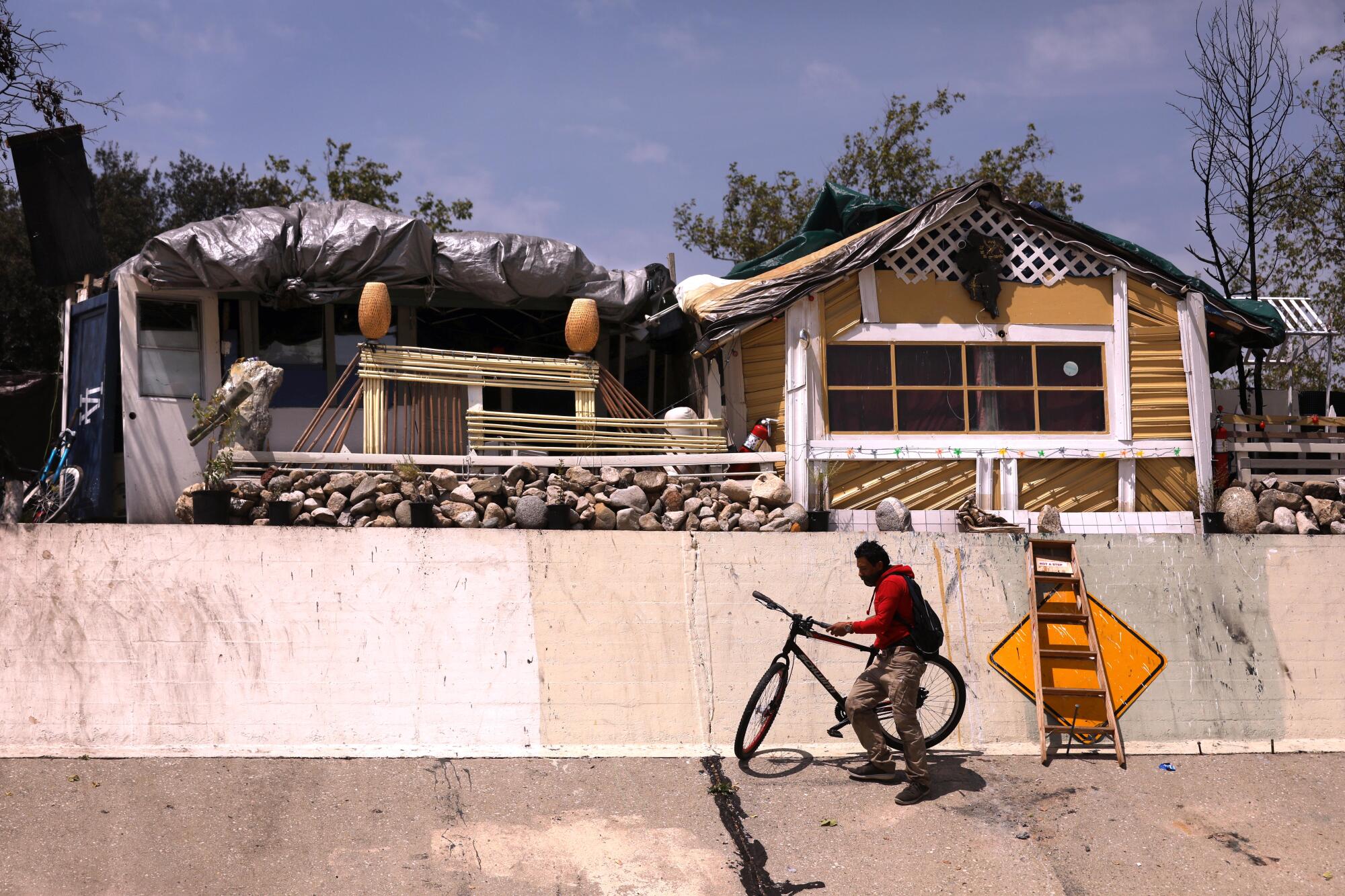
- Share via
In a city of multimillion-dollar houses and celebrity estates, Cesar Augusto’s home stands apart.
The walls consist of discarded fencing and wood paneling repurposed by Augusto, a tarp serves as a roof, and the front yard is the industrial backdrop of a city’s flood channel.
Balanced on a thin slice of land between the 110 Freeway and the Arroyo Seco flood channel, the home — not a house in the conventional sense — is framed under a stand of trees by a white lattice fence and window shutters. The rectangular shelter appears above the channel like a section of a wood-paneled suburban basement, and a sign hangs near the entrance: “Ponte trucha,” or “Stay sharp.”
Augusto climbs a ladder up the steep wall of the channel to reach his makeshift shelter, another example of the extreme measures taken by many Angelenos struggling to find a place to live in one of the most expensive housing markets in the country.
The unhoused in Los Angeles sleep in tents on the street, in government-built tiny home villages or in converted hotels. Those with construction skills and a bit of ingenuity — like Augusto — build their own shelters on whatever strip of unused or discarded land they can commandeer.
Augusto, 43, arrived in Los Angeles roughly 20 years ago from Guatemala. For 15 years he worked as a house painter throughout Los Angeles County, but he struggled to find jobs after his employer died five years ago.
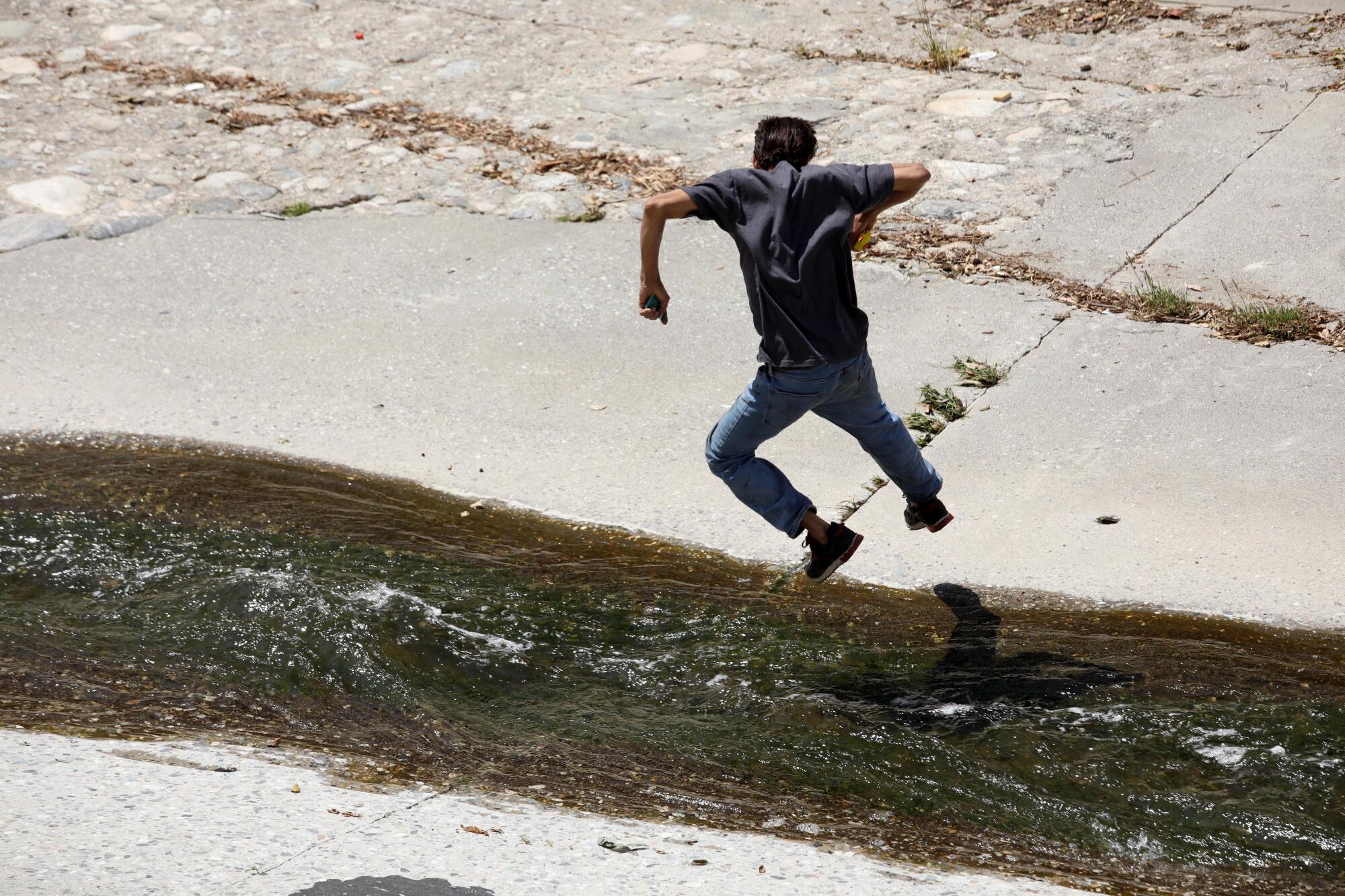
“There wasn’t enough to live on. And it just became harder and harder to pay for a room to live in,” Augusto said in Spanish while standing in the concrete channel, which carries runoff through the Highland Park neighborhood.
Several TV news crews have passed through his riverside community in the last few days, asking him and his neighbors about their way of life. Augusto doesn’t understand what all the fuss is about. He’s just trying to keep a roof over his head.
Reporters have recently focused on his neighbor, Alejandro Diaz, who built a much more elaborate shelter than Augusto — one that sports a bright yellow facade, decorative plants, solar panels and a concrete path leading to his front door. The shelter appears above the flood wash like a seaside cottage plucked from a coastal town.
One reporter described Diaz’s home as having “riverfront appeal,” and other news stories have highlighted the ingenuity of the encampment amid an ongoing homelessness crisis.
L.A. City Councilwoman Eunisses Hernandez, who grew up in Highland Park and represents the area where Augusto lives, said there aren’t enough housing options to accommodate everyone experiencing homelessness in the city.
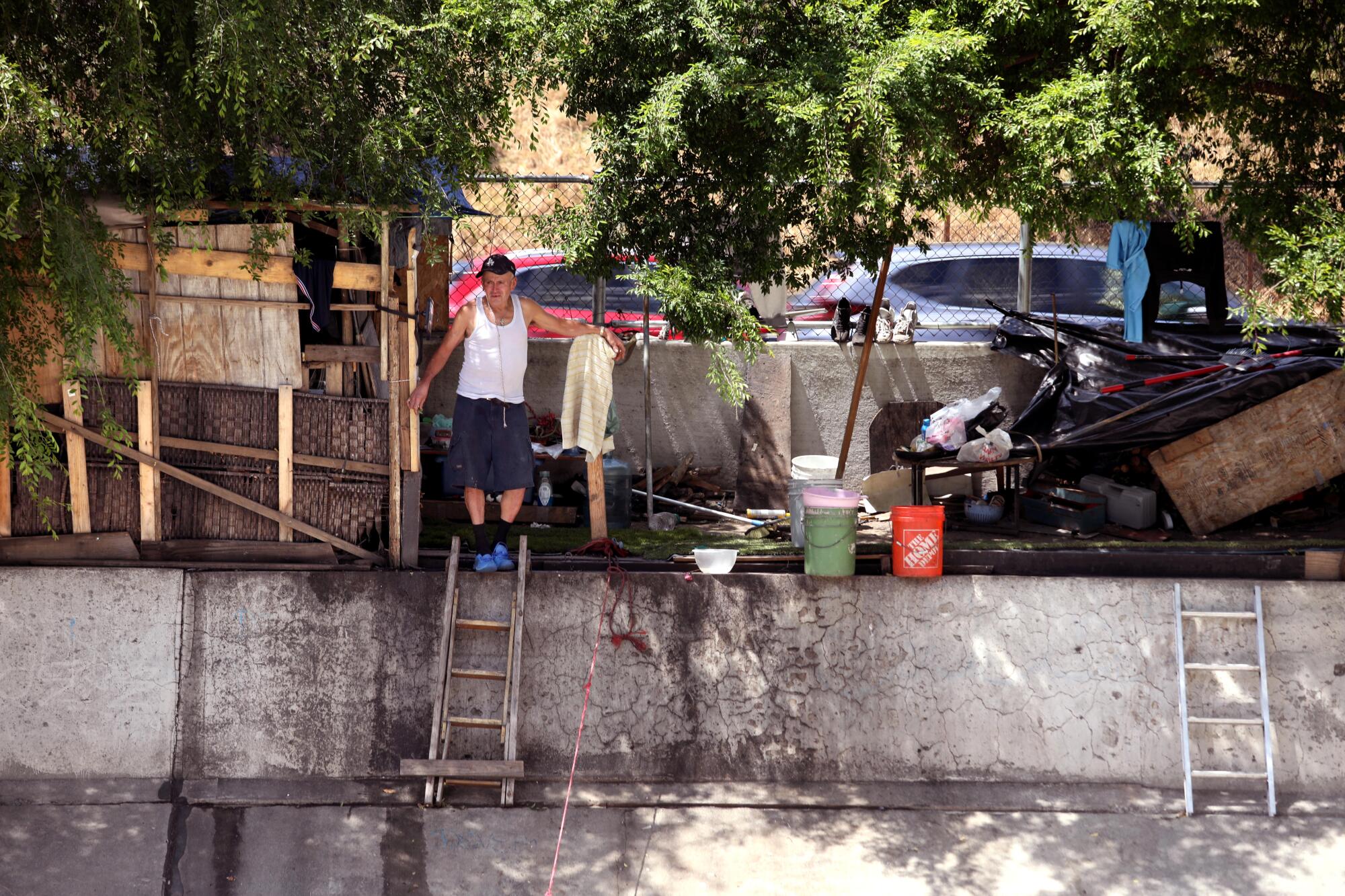
In a statement, Hernandez’s office said she “believes that this status quo is unacceptable and is working to urgently address this crisis, with both short-term and long-term solutions.”
“Our outreach teams are working to urgently find housing for the individuals living in this encampment and address the safety issues posed by this structure and its proximity to the river,” Hernandez said, referring to the homes that have received so much attention lately.
Augusto’s shelter has stood for at least four years, but he does not recall anyone from the city visiting in the last several days and has not had any issues with officials trying to move him out of his spot. Still, he knows that other unhoused residents lost their temporary shelters when the city conducted encampment sweeps.
Seven homeless Angelenos sued the city after their belongings were destroyed during encampment sweeps in 2018 and 2019, according to their lawsuit. A federal judge recently ruled that the city altered evidence to support the its defense in the lawsuit and will probably face sanctions.
Though Augusto’s shelter along the Arroyo Seco is relatively simple, he cherishes the objects that make it feel like a home. He has repurposed items and materials he’s found on the street or in trash bins, such as rope, fencing, window shutters and buckets for cleaning dishes. He admits his setup needs work, and his girlfriend is helping him now that they have lived together for almost a year.
A few yards away is Diaz’s home, which stands out with its yellow facade.
A set of French doors cover the entrance next to a red refrigerator powered by a solar panel and a battery that are just strong enough to keep a carton of almond milk chilled. The channel below serves as a sink for some people in the community, who use the murky water to wash their hands and clothes. A gnarled tree branch functions as a clothesline.
Between Diaz’s and Augusto’s shelters is a rope hammock and a drum set for a video game, but no TV or gaming console to play it on. In lieu of shingled roofs, faded tarps drape over their structures and hang over their heads while they sleep at night.
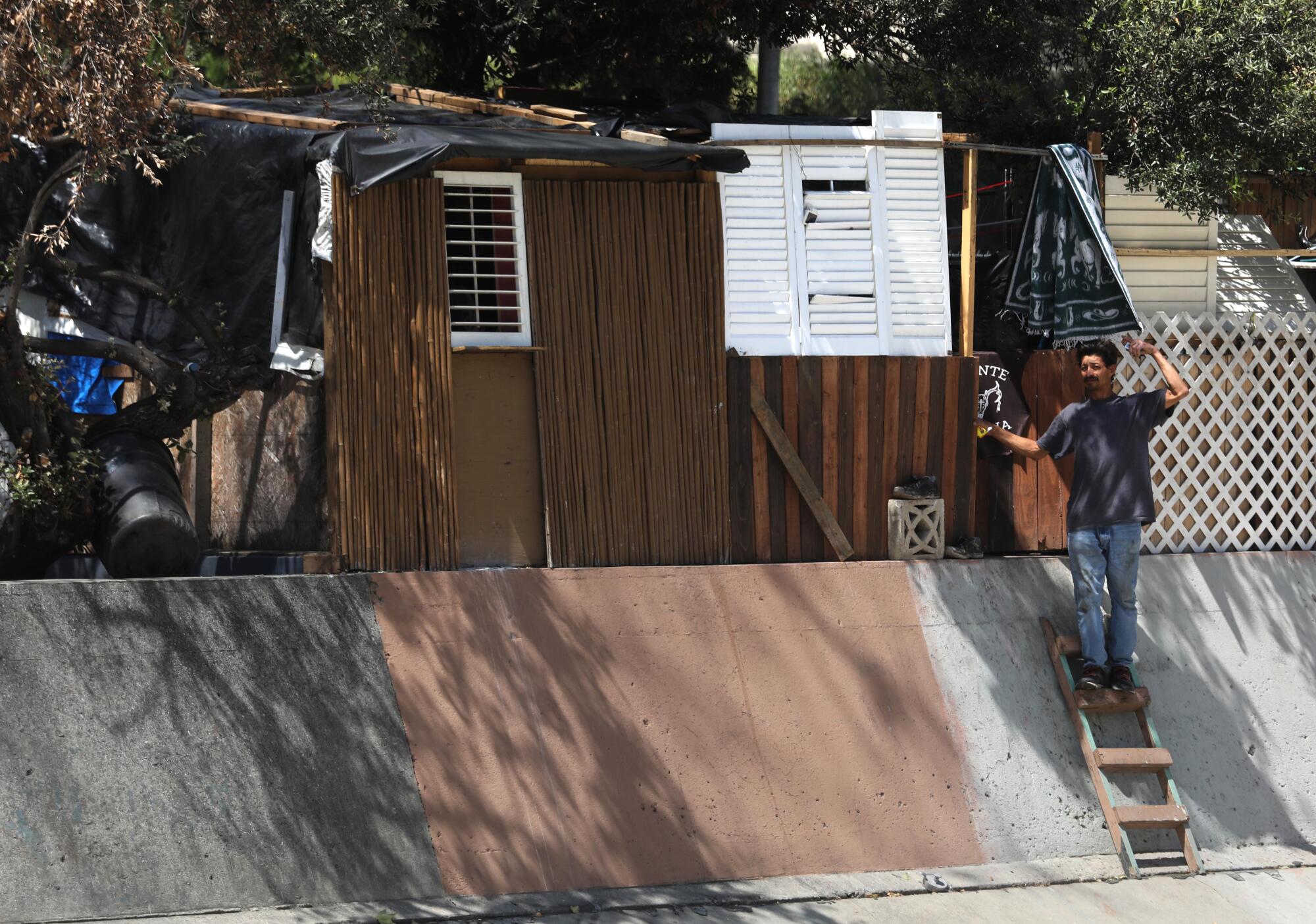
“People give up on these things,” Augusto said, pointing to his shelter.
Occasionally, he finds work as a day laborer, but it’s not a stable source of income. He sighs and points to the flood channel.
“Está tranquilo,” he said. “It’s calm here.”
On the ledge of a concrete channel, he has built a temporary sanctuary at a time when so many throughout the region are struggling to get by. Roughly four in 10 renters in Los Angeles County live in fear of becoming homeless, according to a recent study from UCLA’s Luskin School of Public Affairs.
The elusive promise of home ownership is a moving target for a wide swath of Southern Californians, with the average price of a home coming in at $869,082, according to the latest data from Zillow. The median rent for a one-bedroom apartment in Los Angeles in 2024 is more than $2,000 a month, according to the U.S. Department of Housing and Urban Development.
Nearly 30% of the people in the U.S. who experienced homelessness for at least one night in January 2023 were in California, according to a federal point-in-time count released in December.
Los Angeles Mayor Karen Bass declared a state of emergency on homelessness shortly after she took office in December 2022. Her first budget allocated $1.3 billion to address the growing crisis, with the number of people living on the streets rising 80% since 2015. The latest estimate is 46,000 homeless people in the city of Los Angeles.
The growth of homeless communities in open spaces throughout the city speaks to that problem, whether they’re under freeway onramps, in RVs lining the curbs or in encampments in and around green spaces.
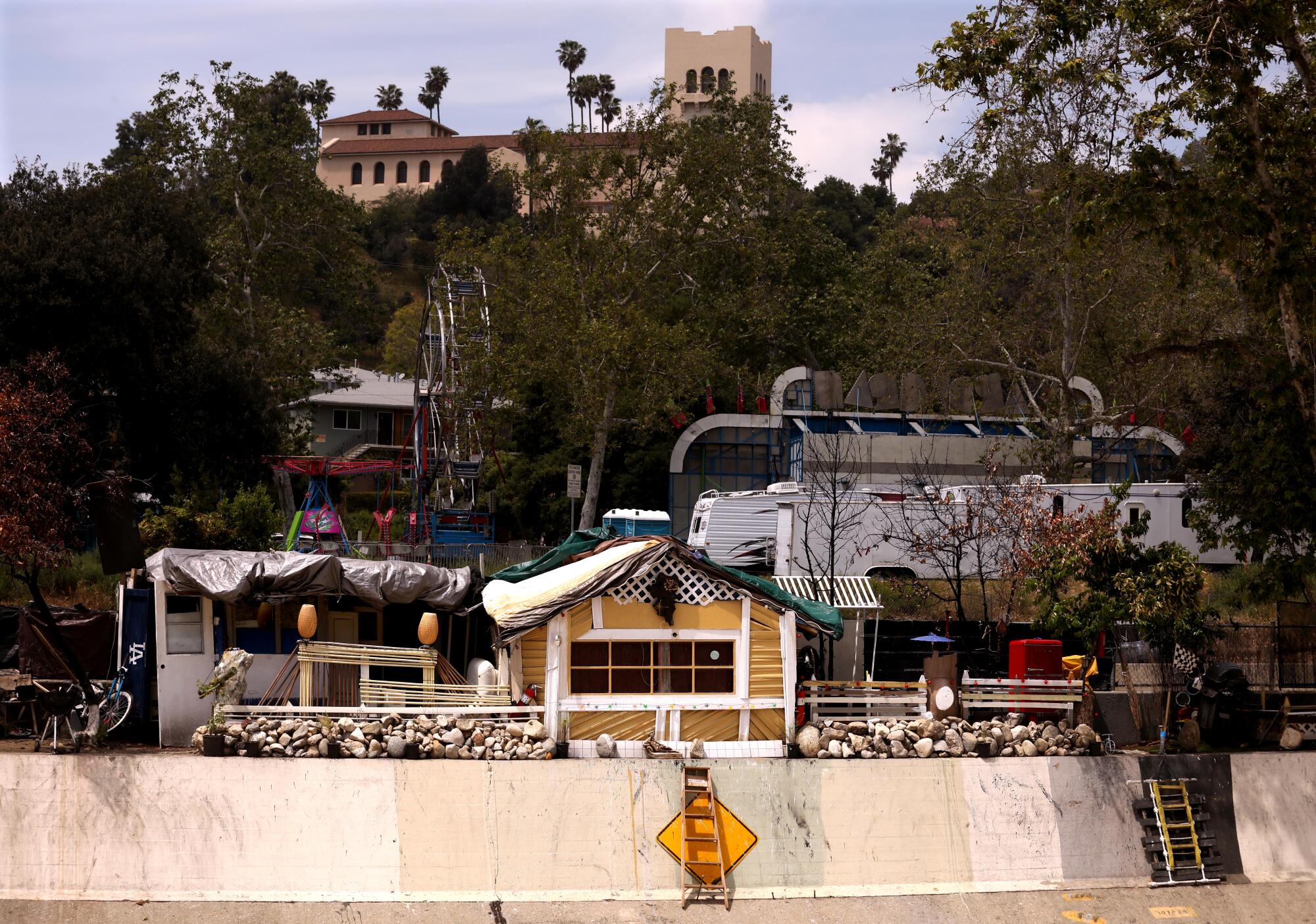
Augusto’s shelter is not unique along the Arroyo Seco, as many other dwellings have sprouted along the channel.
One Arroyo Seco dweller is a woman named Socorro, who said she had to leave the Lincoln Heights apartment she shared with her boyfriend after she lost her job at a Mexican market. The couple lived on the streets for several months, she said, before she woke up one morning to discover that her boyfriend and his stuff were gone.
“I’ve found some nice people here by the river and freeway,” she said as she walked along the channel, where river rocks poked through the concrete.
About a mile away stands the Arroyo Seco Tiny Home Village, with 117 cabins that are intended to act as transitional housing. Two other tiny villages, also located in the council district represented by Councilman Kevin de León, are similarly meant to act as a steppingstone to permanent housing. De León’s office did not respond to requests for comment about the encampments along the Arroyo Seco.
Despite the recent spring rainstorms, the water in the steep flood channel hasn’t come anywhere near Augusto’s home. Every Sunday, a group of volunteers descend on the river community and bring food, Augusto said, but he cannot recall the church they’re affiliated with or if they are local to the neighborhood.
Traffic on the 110 Freeway keeps a steady hum while the quiet swish of water passes through the Arroyo Seco wash.
On a sunny April afternoon, a lean man in his mid-40s, wearing a gray shirt and jeans, rides a bicycle past Augusto’s home and calls his name. He walks up to Augusto’s entrance, and the two converse in hushed tones.
Augusto nods and ducks away, returning a second later to hand the man a frying pan, possibly a loan or a gift to a fellow struggling unhoused Angeleno. The man holds it up and smiles as he heads to his own shelter.
More to Read
Sign up for This Evening's Big Stories
Catch up on the day with the 7 biggest L.A. Times stories in your inbox every weekday evening.
You may occasionally receive promotional content from the Los Angeles Times.












